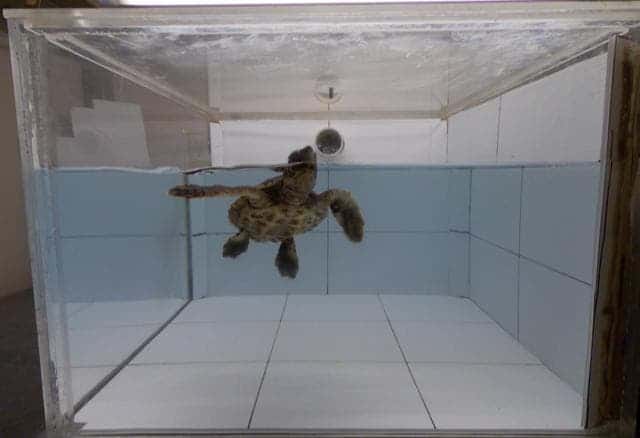
It has long been thought that sea turtles are attracted to plastic debris and ingest them because they mistake them for prey, such as jellyfish. But it actually seems to be a lot worse than that. A new study showed that the turtles are attracted to plastic debris not only by the way it looks, but by the way it smells too.
Literally junk food
Loggerhead turtles often ingest plastic debris such as handbags or bottle caps, causing them to become ill or stranded on the beach with their digestive system full or partially blocked.
In order to study the behavior of sea turtles around marine plastic debris, researchers at the University of North Carolina at Chapel Hill and the University of Florida compared how 15 young, captive-reared loggerheads (Caretta caretta) reacted to the odors of turtle food, ocean-soaked plastic, clean plastic, and deionized water.
According to the results of an experiment performed in a laboratory setting, the turtles ignored the scents of clean plastic and water. However, when exposed to the smell of food and soaked plastics, the turtles became attracted to the scents and began exhibiting foraging behaviors. This included poking their noses out of the water, a sign that they were trying to identify the food source. They also became more physically active as they searched for food.
Biofouled plastics build a coating of algae, plants, plankton, and microorganisms, which may explain why the turtles mistake them for food. However, the scientists were extremely surprised to find that the marine creatures responded to the odors of biofouled plastic with the same intensity as they would to the smell of fish and shrimp, their favorite food. Compared to water and clean plastic, the turtles kept their noses out of the water more than three times longer.
“We expected them to respond to both to a greater extent than the control treatments, but the turtles know the smell of their food since they’ve been smelling and eating it in captivity for 5 months. I expected their responses to food to be stronger,” Joseph Pfaller of the University of Florida, Gainesville said in a statement.
No turtle involved in the study was allowed to ingest plastic and were later released into the ocean after the research was over.
These findings help to explain why turtles, especially very young turtles that tend to swim closer to the surface than older turtles, are so affected by marine pollution.
“The plastic problem in the ocean is more complex than plastic bags that look like jellyfish or the errant straw stuck in a turtle’s nose,” Pfaller said. “These are important and troubling pieces to the puzzle, and all plastics pose dangers to turtles.”
Nearly all species of sea turtle are classified as Endangered, and plastic is doing more than its share of damage.
Globally it’s estimated that approximately 52% of all sea turtles have eaten plastic. In 2018, researchers at Australia’s Commonwealth Scientific and Industrial Research Organisation (CSIRO) estimated that 90% of juvenile green sea turtles off the coast of Brazil have ingested plastic. They also found that once a turtle had ingested 14 plastic itemts, there was a 50% likelihood that it would die.
According to a study undertaken by the World Economic Forum, the Ellen MacArthur Foundation, and McKinsey and Company, 32% of the 78 million tons of plastic packaging produced annually winds up in the ocean — that’s equivalent of pouring one garbage truck of plastic into the ocean every minute.
“In parts of the Pacific Ocean there are huge areas covered with floating plastic debris,” said Kenneth J. Lohmann, a professor of biology at the University of North Carolina. “One concern this study raises is that dense concentrations of plastics may make turtles – or other species – think the area is an abundant source of food. These areas may draw in marine mammals, fish and birds because the area smells like a good foraging ground. Once these plastics are in the ocean, we don’t have a good way to remove them or prevent them from smelling like food. The best thing we can do is to keep plastic from getting into the ocean at all.”
The findings appeared in the journal Current Biology.






